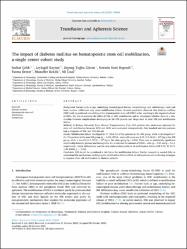| dc.contributor.author | Çelik, Serhat | |
| dc.contributor.author | Kaynar, Leylagül | |
| dc.contributor.author | Güven, Zeynep Tuğba | |
| dc.contributor.author | Keni Beğendi, Nermin | |
| dc.contributor.author | Demir, Fatma | |
| dc.contributor.author | Keklik, Muzaffer | |
| dc.contributor.author | Ünal, Ali | |
| dc.date.accessioned | 2023-12-11T12:14:19Z | |
| dc.date.available | 2023-12-11T12:14:19Z | |
| dc.date.issued | 2023 | en_US |
| dc.identifier.citation | Çelik, S., Kaynar, L., Güven, Z. T., Begendi, N. K., Demir, F., Keklik, M., & Ünal, A. (2023). The impact of diabetes mellitus on hematopoietic stem cell mobilization, a-single center cohort study. Transfusion and Apheresis Science, 103838. | en_US |
| dc.identifier.issn | 1473-0502 | |
| dc.identifier.uri | https://dx.doi.org/ 10.1016/j.transci.2023.103838. | |
| dc.identifier.uri | https://hdl.handle.net/20.500.12933/1825 | |
| dc.description.abstract | Background: Factors such as age, underlying hematological disease, chemotherapy and radiotherapy used, and bone marrow infiltration may cause mobilization failure. Several preclinical observed that diabetes mellitus (DM) leads to profound remodeling of the hematopoietic stem cell (HSC) niche, resulting in the impaired release of HSCs. We aim to examine the effect of DM on HSC mobilization and to investigate whether there is a relationship between complications developing in the DM process and drugs used to treat DM and mobilization failure.
Methods: In Erciyes University Bone Marrow Transplantation Unit, 218 patients who underwent apheresis for stem cell mobilization between 2011 and 2021 were evaluated retrospectively. One hundred and nine patients had a diagnosis of DM, and 109 did not.
Results: Mobilization failure developed in 17 (15.6 %) of the patients in the DM group, while it developed in 7 (6.4 %) patients in the non-DM group (p = 0.03). CD34+ stem cell count was 8.05 (1.3-30.2) × 106/kg in the DM group, while it was 8.2 (1.7-37.3) × 106/kg in the other group (p = 0.55). There was no statistically significant relationship between glucose and hemoglobin A1c levels and the amount of CD34+ cells (p = 0.83 and p = 0.14, respectively). Using sulfonylurea was the only independent predictor of mobilization failure (OR 5.75, 95 % CI: 1.38-24.05, p = 0.02).
Conclusion: DM should be considered a risk factor for mobilization failure. Further research is needed fully to understand the mechanisms underlying the mobilization failure effects of sulfonylureas and to develop strategies to improve stem cell mobilization in diabetic patients. | en_US |
| dc.language.iso | eng | en_US |
| dc.publisher | Elsevier Science | en_US |
| dc.relation.isversionof | 10.1016/j.transci.2023.103838. | en_US |
| dc.rights | info:eu-repo/semantics/embargoedAccess | en_US |
| dc.subject | Diabetes Mellitus | en_US |
| dc.subject | Hematopoietic Stem Cell | en_US |
| dc.subject | Mobilization | en_US |
| dc.subject | Sulfonylurea | en_US |
| dc.title | The impact of diabetes mellitus on hematopoietic stem cell mobilization, a-single center cohort study | en_US |
| dc.type | article | en_US |
| dc.authorid | 0000-0002-7570-1552 | en_US |
| dc.department | AFSÜ | en_US |
| dc.contributor.institutionauthor | Keni Beğendi, Nermin | |
| dc.identifier.volume | 62 | en_US |
| dc.identifier.issue | 6 | en_US |
| dc.relation.journal | Transfusion and apheresis science : official journal of the World Apheresis Association : official journal of the European Society for Haemapheresis | en_US |
| dc.relation.publicationcategory | Makale - Ulusal Hakemli Dergi - Kurum Öğretim Elemanı | en_US |
















